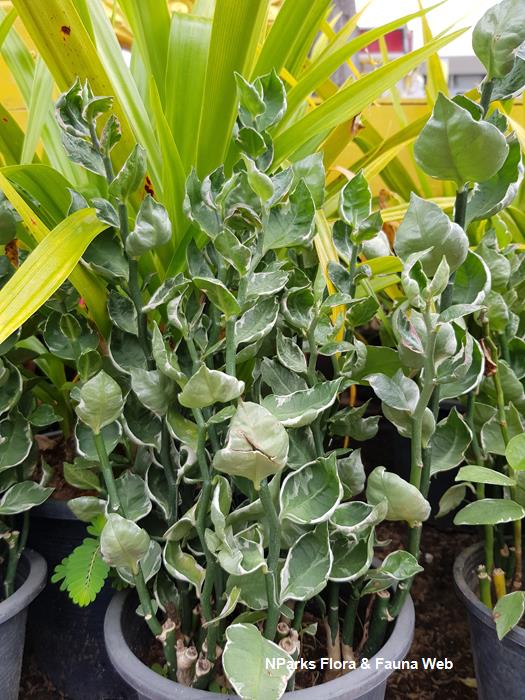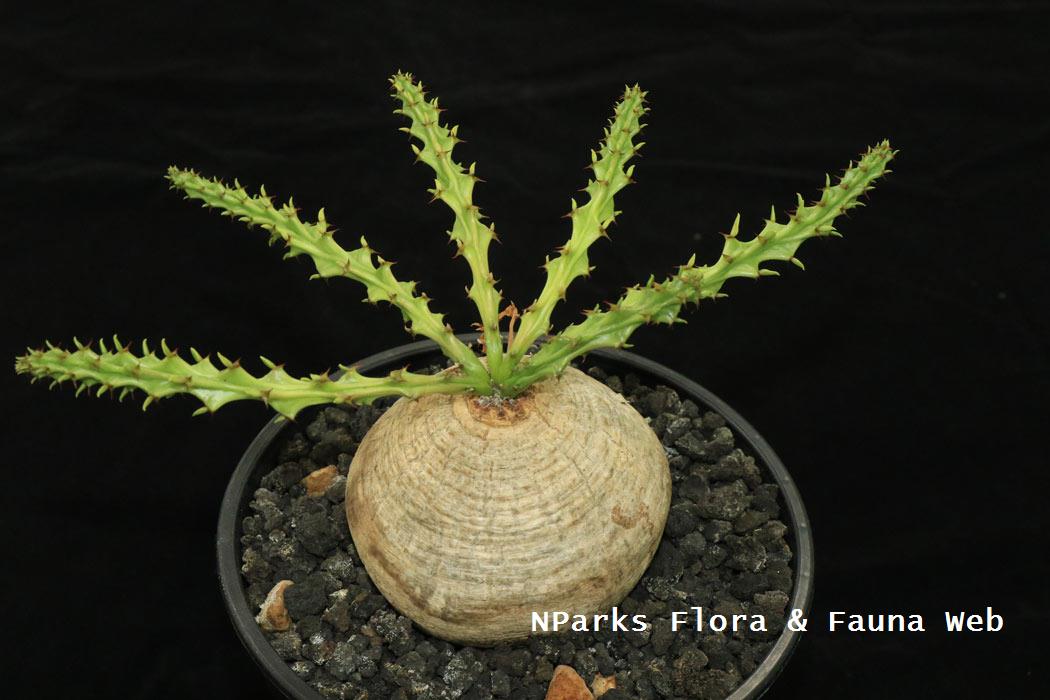
Back
Euphorbia tithymaloides subsp. smallii 'Embraceable You'
| Family Name: | Euphorbiaceae |
| Synonyms: | Pedilanthus tithymaloides 'Embraceable You' |
| Common Name: | Seashell Devil's Backbone, Seashell Zigzag Plant |
Name
Classifications and Characteristics
| Plant Division | Angiosperms (Flowering Seed Plants) (Dicotyledon) |
|---|---|
| Plant Growth Form | Succulent Plant |
| Lifespan (in Singapore) | Perennial |
| Mode of Nutrition | Autotrophic |
| Plant Shape | Shrubby |
| Maximum Height | 0.6 m to 1 m |
Description and Ethnobotany
| Growth Form | Succulent herbaceous sub-shrub, up to around 1m height, with erect form and limited branching. |
|---|---|
| Foliage | Leaves fleshy, crinkled, concavely-cupped like tortoise shells, glossy grey-green with white margins, held close to stems (thus a likely inspiration for its tradename). |
| Stems | Fleshy, powdery grey-green, zigzag and very upright, exude milky sap when cut or bruised. |
| Similar | Subspecies differentiated from species form by cupped leaves and more distinctly zigzag stems. |
| Cultivation | Withstands drought, but sheds leaves under extreme dryness. Moderately salt-tolerant. Prefers well-drained soils with medium fertility. Propagate by stem cuttings. Acrid sap from damaged leaves, stems and roots may irritate skin, toxic if ingested. |
| Etymology | Genus epithet 'Euphorbia' named after Euphorbus -- physician to Juba II, King of Mauretania (52BC- 23AD). Ancient Greek philosopher Pliny recounted that Juba called a plant he found at Mount Atlas Euphorbia in honour of his physician. Species epithet 'tithymaloides' means resembling the genus Tithymalus (defunct, now synonym of Euphorbia) -- an ancient Greek name for a group of plants with milky sap. Subspecies epithet 'smallii' named after American botanist Dr. John Kunkel Small (1869-1938), who served as the first Curator of Museums at New York Botanical Garden, and travelled extensively across Florida to document its flora and landmarks. |
Landscaping Features
| Desirable Plant Features | Ornamental Foliage, Ornamental Stems |
|---|---|
| Landscape Uses | Coastal, Suitable for Rooftops, Container Planting |
| Thematic Landscaping | Silver Garden, Rockery / Desert Garden |
| Usage Hazard - Cons | Irritant - Sap, Toxic Upon Ingestion |
| Usage Hazard - Cons Remarks | Milky sap |
Plant Care and Propagation
| Light Preference | Full Sun |
|---|---|
| Water Preference | Little Water |
| Plant Growth Rate | Slow |
| Rootzone Tolerance | Drought Tolerant, Fertile Loamy Soils, Well-Drained Soils, Poor Infertile Soils, Saline Soils / Salt Spray, Shallow Media |
| Maintenance Requirements | Low |
| Propagation Method | Stem Cutting |
Foliar
| Foliage Retention | Evergreen |
|---|---|
| Mature Foliage Colour(s) | Green, Silver / Grey, White |
| Mature Foliage Texture(s) | Glossy / Shiny, Thick, Crinkled / Twisted |
| Foliar Type | Simple / Unifoliate |
| Foliar Arrangement Along Stem | Alternate |
| Foliar Shape(s) | Non-Palm Foliage (Ovate) |
| Foliar Venation | Pinnate / Net |
| Foliar Margin | Entire - Wavy / Undulate |
| Foliar Apex - Tip | Acuminate |
| Foliar Base | Acute |
Non - Foliar and Storage
| Stem Type & Modification | Herbaceous |
|---|---|
| Root Type | Underground (Fibrous Root) |
| Specialised Storage Organ(s) | Aboveground |
Floral (Angiosperm)
| Flower & Plant Sexuality | Bisexual Flowers |
| Flowering Period | Rarely |
|---|---|
| Flowering Habit | Polycarpic |
Image Repository
Others
| Master ID | 29446 |
|---|---|
| Species ID | 3755 |
| Flora Disclaimer | The information in this website has been compiled from reliable sources, such as reference works on medicinal plants. It is not a substitute for medical advice or treatment and NParks does not purport to provide any medical advice. Readers should always consult his/her physician before using or consuming a plant for medicinal purposes. |








